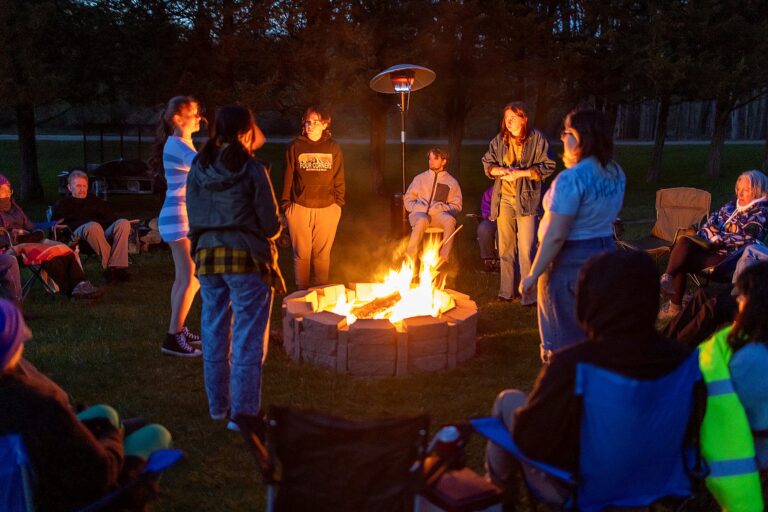Pre-pandemic, “live and in-person” meant just that. Today, most “live and in-person” events take place via live stream and virtual platforms, which is especially challenging when it comes to education and the arts.
With a focus on safety and a lot of Spartans Will, the MSU Department of Theatre has adapted to the “new normal” while regaining the ability to teach and learn their artistry in person. Assistant Professor of Musical Theatre and Choreography Brad Willcuts is among the few faculty university-wide leading in-person instruction. In January 2021, he resumed his dance class and his musical theatre acting class on campus while retaining some innovations from the virtual world.
“I put a bunch of energy into trying to make sure we were able to be here,” he said. “Luckily, we were granted the opportunity, and we’re glad that MSU has the resources that they do to make sure it’s safe.”
It’s impossible to understand an actor’s or character’s full embodiment of their craft by just seeing them from the shoulders up. Students have to have this in-person experience, and it brings hope toward the future.
Brad Willcuts, Assistant Professor of Musical Theatre and Choreography
Before January, Willcuts was leading sessions remotely. He equipped his students with tools like Adobe Premiere, GarageBand, Logic Pro X, and Final Cut Pro to record and edit, as well as to collaborate with their classmates. Students discovered how to make podcasts, harmonize with their own voices for songs, lip sync, and how to create dance videos and site-specific dance pieces. Occasionally, Willcuts would invite a guest artist to speak about their craft via Zoom.

Willcuts was inspired by the creative output of his students in the virtual world and said that audio-visual elements will likely become part of the curriculum moving forward. But nothing, he said, can compare to experiencing or teaching dance, choreography, and theatre in its traditional form.
“There’s simply an overall energy about it and about connecting with an audience,” he said. “It’s impossible to understand an actor’s or character’s full embodiment of their craft by just seeing them from the shoulders up. Students have to have this in-person experience, and it brings hope toward the future.”
Palpable Movement
Alexis Black has a hard time explaining the excitement of being back on campus and able to work with Theatre students when she resumed an in-person class in January.
“It’s just palpable,” she said. “The first day when students came in, we all felt so distant from each other. But we all knew this was what we love about theatre: Being in a space with each other and feeling what it would be like to have an audience again.”

As an Assistant Professor of Acting and Movement, Black carefully researched what it would take to schedule a stage combat class. She talked with colleagues at MSU, other universities, and colleagues from national organizations such as the Association of Theatre Movement Educators. She discovered that having a giant, well-ventilated space with plenty of room to socially distance could help ensure the health and safety of her students. That space and the resources she needed were within minutes of her previous classroom in the MSU Auditorium and available at the MSU Wharton Center for Performing Arts.
The Department of Theatre has been working closely with Wharton Center staff since summer to develop protocols that would allow a safe return to studio learning for its teaching artists and their students. The large spaces at Wharton Center allow for classes to be in an environment where they can safely work in person.
If there’s a silver lining in all this, it’s become even more clear to students how important it is to tell a very clear story with their bodies since masks and distance make it difficult to see emotion in someone’s face.
Alexis Black, Assistant Professor of Acting and Movement
Black worked with the Wharton facilities team and set guidelines for the temporary use of the Great Hall for her class. She retooled parts of her curriculum to leverage the use of masks and movement to tell stories. The result, she said, was an exceptional experience for students.
“As a movement teacher, something we always talk about with actors is getting all that emotion out of your face and into your body,” she said. “If there’s a silver lining in all this, it’s become even more clear to students how important it is to tell a very clear story with their bodies since masks and distance make it difficult to see emotion in someone’s face.”

Black admits that teaching theatre during COVID-19 has presented both emotional and logistical challenges, particularly with remote learning. But she admits, too, she’s seen the value of technology and looks to integrate additional video, filming equipment like body cams and communication platforms into future classes.
“Students get to be a part of building and designing with us,” she said. “They’re working with us to create work in a new way. It’s a great opportunity as they go into the world and think about how they can be entrepreneurs and do these things themselves.”
Working Through Grit
Freshman Theatre major Joie Culligan agreed that having on-site classes has given her extra motivation during the pandemic. A freshman Theatre major from California, Culligan had been taking virtual classes from home since the university made the temporary switch to online courses in March 2020.

While learning how to dance over Zoom was a skill in and of itself, Culligan was elated by the chance to learn and practice on campus. She understood that the university was taking proper measures to guard against the spread of COVID-19 and convinced her parents to let her move back to Michigan to resume taking classes in-person at MSU.
“Just getting to dive into jazz and contemporary technique again was pretty crazy and really helpful,” she said. “What surprised me was the supportive environment that’s created here and how much I’ve been able to grow as a dancer even in this short period of time.”
Just getting to dive into jazz and contemporary technique again was pretty crazy and really helpful. What surprised me was the supportive environment that’s created here and how much I’ve been able to grow as a dancer even in this short period of time.
Joie Culligan, freshman Theatre major
Willcuts said he was awed by the ability of his students to stay positive through the adversity and to remain committed to their goals and dreams. Reflecting, he hopes the momentum toward normalcy will continue in the fall, and that his class is a step toward a brighter future.
“We’ve all been through a little bit of grit, so I think we all have a better appreciation for how lucky we are being able to dance, act, and sing in person,” he said. “One thing I do find true about adversity is it’s easier to see the light when you’ve been through the darkness.”


